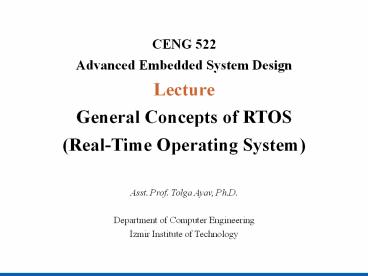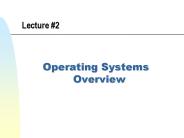CENG 522 Advanced Embedded System Design Lecture - PowerPoint PPT Presentation
1 / 23
Title:
CENG 522 Advanced Embedded System Design Lecture
Description:
CENG 522 Advanced Embedded System Design Lecture General Concepts of RTOS (Real-Time Operating System) Asst. Prof. Tolga Ayav, Ph.D. Department of Computer Engineering – PowerPoint PPT presentation
Number of Views:320
Avg rating:3.0/5.0
Title: CENG 522 Advanced Embedded System Design Lecture
1
CENG 522 Advanced Embedded System
DesignLecture General Concepts of
RTOS (Real-Time Operating System) Asst. Prof.
Tolga Ayav, Ph.D.Department of Computer
EngineeringIzmir Institute of Technology
2
Operating System
- Specialized collection of system programs is
called operating system. - Must provide at least three specific functions
- Task scheduling
- Task dispatching
- Intertask communication
- Kernel (Nucleus) The smallest portion of OS that
provides those three essential functions.
Izmir Institute of Technology
Embedded Systems Lab
3
Role of the Kernel
Izmir Institute of Technology
Embedded Systems Lab
4
Three Kernel Functions
- OS Kernel - 3 functions
- Task Scheduler To determine which task will
run next in a multitasking system - Task Dispatcher To perform necessary
bookkeeping to start a task - Intertask Communication To support
communication between one process (i.e. task)
and another
Izmir Institute of Technology
Embedded Systems Lab
5
Kernel Design Strategies
- Polled Loop Systems
- Cyclic Executive
- Cooperative Multitasking
- Interrupt-Driven Systems
- Foreground/Background Systems
- Full featured RTOS
Izmir Institute of Technology
Embedded Systems Lab
6
1. Polled Loop Systems
Polled loops are used for fast response to single
devices. In a polled-loop system, a single and a
repetitive instruction is used to test a flag
that indicates whether or not some event has
occurred. If the event has not occurred, then the
polling continues.
Example suppose a software system is needed to
handle packets of data that arrive at a rate of
no more than 1 per second. A flag named
packet_here is set by the network, which writes
the data into the CPUs memory via direct memory
access (DMA). The data are available when
packet_here 1. Using a C code fragment, such a
polled loop to handle such a system is
for() / do forever / if (packet_here) /
check flag / process_data() / process data
/ packet_here0 / reset flag /
Izmir Institute of Technology
Embedded Systems Lab
7
Synchronized Polled Loop (1)
A variation on the polled loop uses a fixed clock
interrupt to pause between the time when the
signaling event is triggered and then reset. Such
a system is used to treat events that exhibit
switch bounce.
Example suppose a polled-loop system is used to
handle an event that occurs randomly, but no
more than once per second. The event is known to
exhibit a switch-bounce effect that disappears
after 20 milliseconds. A 10-millisecond
fixed-rate interrupt is available for
synchronization. The event is signaled by an
external device that sets a memory location via
DMA. The C code looks like the following
for() / do forever / if(flag) / check
flag / pause(20) / wait 20 ms
/ process_event() / process event
/ flag0 / reset flag /
Izmir Institute of Technology
Embedded Systems Lab
8
Synchronized Polled Loop (2)
for() / do forever / if(flag) / check
flag / counter 0 while(counterlt3)
process_event() / process event / flag0
/ reset flag /
10ms interrupt service routine might look like
countercounter1
Izmir Institute of Technology
Embedded Systems Lab
9
2. Cyclic Executive
Cyclic executives are noninterrupt-driven
systems that can provide the illusion of
simultaneity by taking advantage of relatively
short processes on a fast processor in a
continuous loop.
for() task_1() task_2() ... task_n()
for() task_1() task_2() task_1() task
_3()
If each process is relatively short and uniform
in size, then reactivity and simultaneity can be
achieved without interrupts. Moreover, if
each process is carefully constructed including
synchronization through messaging or global
variables, complete determinism and
schedulability can be achieved.
Izmir Institute of Technology
Embedded Systems Lab
10
3. Cooperative Multitasking
Two or more processes are coded in the
state-driven fashion just discussed, and after
each phase is complete, a call is made to a
central dispatcher. The dispatcher holds the
program counter for a list of processes that are
executed in round-robin fashion that is, it
selects the next process to execute. Known as
code-driven finite state automata approach.
void process_a(void) for()
switch(state_a) case 1 phase_a1() break
case 2 phase_a2() break case 3
phase_a3() break case 4
phase_a4() break case 5
phase_a5() break
void process_b(void) for()
switch(state_b) case 1 phase_b1() break
case 2 phase_b2() break case 3
phase_b3() break case 4
phase_b4() break case 5
phase_b5() break
break commands call dispatcher. State_a and
state_b are global variables managed by the
dispatcher. This is simpliest form of fairness
scheduling.
Izmir Institute of Technology
Embedded Systems Lab
11
4. Interrupt-Driven Systems
In interrupt-driven systems, the main program is
a single jump-to-self instruction. The various
tasks in the system are scheduled via either
hardware or software interrupts, whereas
dispatching is performed by the
interrupt-handling routines.
void main(void) for()
void _isr_1(void) ...
void _isr_n(void) ...
...
Hardware Interrupt A signal generated by a
peripheral device and sent to the CPU. In turn,
the CPU executes an interrupt service routine
(ISR), which takes action in response to the
interrupt. Software Interrupt Similar to the
hardware interrupt, in that it causes one code
module to pass control to another.
Izmir Institute of Technology
Embedded Systems Lab
12
Hardware Interrupts and ISRs
- An interrupt can happen at any time
(Asynchronous). - CPU invokes the ISR.
- Around the code that reads/writes to the shared
resourcesinterrupts are disabled in the
application. - Synchronization mechanisms cannot be used in ISR,
because ISR should not wait indefinitely. - When interrupts are disabled, the systems
ability to receive stimuli from the outside
world is minimal. - It is important to keep the critical sections of
code in which the interrupts are disabled as
short as possible. - ISRs can be reentrant where applicable
- A snapshot of the machine called the context
must be preserved upon switching tasks so that
it can be restored upon resuming the
interrupted process.
Izmir Institute of Technology
Embedded Systems Lab
13
Context Switch
Saving the minimume amount of information
necessary to safely restore any process after it
has been interrupted. This information ordinarily
includes
- Contents of general purpose registers
- Contents of the program counter
- Contents of special registers (e.g. Flags)
- Memory page register
- Images of memory mapped I/O locations (mirror
images)
void _isr_1(void) save(context) task_1()
restore(context)
void _isr_n(void) save(context) task_n()
restore(context)
void main(void) for()
...
Izmir Institute of Technology
Embedded Systems Lab
14
Preemptive-Priority Systems
A higher-priority task is said to preempt a
lower-priority task if it interrupts the
lower-priority task. Systems that use preemption
schemes instead of round-robin or
first-come-first-served scheduling are called
preemptive-priority systems.
Izmir Institute of Technology
Embedded Systems Lab
15
5. Foreground-Background Systems
Foreground/background systems are an improvement
over the interrupt-only systems in that the
polled loop is replaced by code that performs
useful processing. Foreground/background systems
are the most common architecture for embedded
applications.
Initialization 1. Disable interrupts 2. Set up
interrupt vectors and stacks 3. Perform
self-test 4. Perform system initialization 5.
Enable interrupts
Izmir Institute of Technology
Embedded Systems Lab
16
Background Process
- Not time critical
- What kind of funtions are appropriate ?
p time-loading factor for all foreground
tasks e execution time of background task t
background process execution period
t e / (1 - p)
Execution period can be very low!
Izmir Institute of Technology
Embedded Systems Lab
17
Example Background ProcessWatchdog Timer
void task_1(void) while(1) wdt_10 ...
wdt_10 ... wait()
void task2_n(void) while(1) wdt_n0 ...
wait()
...
more frequently
void main(void) for() wdt_1 ...
wdt_n if(wdt_1gt10) reset_system() .
.. else if(wdt_ngt500) reset_system()
Izmir Institute of Technology
Embedded Systems Lab
18
Full-Featured RTOS
The foreground/background solution can be
extended into an operating system by adding
additional functions such as network interfaces,
device drivers, and complex debugging tools.
These types of systems are readily available as
commercial products. Such systems rely on a
complex operating system using round-robin,
preemptivepriority, or a combination of both
schemes to provide scheduling the operating
system represents the highest priority task,
kernel, or supervisor.
- VxWorks
- Real-Time Unix
- Real-Time Linux
- ...
Izmir Institute of Technology
Embedded Systems Lab
19
Real-Time Kernels
- A Kernel, executive or nucleus is the smallest
portion of the OS that provides these functions - Rea-Time kernels must provide
- A. Interrupt handling, guaranteed interrupt
response - B. Process management (Support for scheduling of
real-time processes and preemptive scheduling) - C. Interprocess communication and
synchronization. - D. Time management.
- E. Memory management
- F. I/O support (Support for communication with
peripheral devices via drivers) - G. High speed data acquisition
- H. Resource management (User control of system
resources) - I. Error and exception handling
Izmir Institute of Technology
Real-Time and Embedded System Design
20
Real-Time Kernel Features
- A real-time OS should provide support for the
creation, deletion and scheduling of multiple
processes - A real-time OS must be able to response an event
and take deterministic (well-defined in terms
of function and time) - action based on the event.
- A real-time OS should support interprocess
communications via reliable and fast
facilities, such as semaphores, shared memory
and message passing. - A real-time system must be able to handle very
high burst rates in high speed data acquisition
applications.
Izmir Institute of Technology
Embedded Systems Lab
21
Task Control Block
Izmir Institute of Technology
Embedded Systems Lab
22
Task States
- Executing
- Ready
- Suspended (or blocked)
- Dormant (or sleeping)
Izmir Institute of Technology
Embedded Systems Lab
23
Task State Diagram
Izmir Institute of Technology
Embedded Systems Lab































